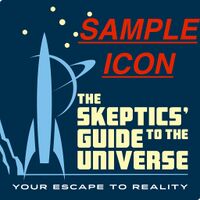SGU Episode 749
You can use this outline to help structure the transcription. Click "Edit" above to begin.
| This transcript is not finished. Please help us finish it! Add a Transcribing template to the top of this transcript before you start so that we don't duplicate your efforts. |
| This episode needs: transcription, time stamps, formatting, links, 'Today I Learned' list, categories, segment redirects. Please help out by contributing! |
How to Contribute |
| SGU Episode 749 |
|---|
| November 16th 2019 |
| (brief caption for the episode icon) |
| Skeptical Rogues |
| S: Steven Novella
|
| Links |
| Download Podcast |
| Show Notes |
| Forum Discussion |
Introduction
Voiceover: You're listening to the Skeptics' Guide to the Universe, your escape to reality.
Whaddya Know: Antimicrobial Copper
News Items
S:
B:
C:
J:
E:
(laughs) (laughter) (applause) [inaudible]
AI: Will to Survive ()
First Cyborg ()
Confessions of an Astrologer ()
National Parks and Mental Health ()
- Cosmos: Using nature to improve mental health[5]
(Transcriptionist's note: Original article from Cosmos in 11/2019 couldn't be found.)
Meat from Air ()
Who's That Noisy? ()
- Answer to last week’s Noisy: _brief_description_perhaps_with_link_
New Noisy ()
[_short_vague_description_of_Noisy]
Questions/Emails/Corrections/Follow-ups ()
Question #1: Craniometry ()
Thank you for the response! I really appreciate you taking the time to respond to me. I would like to clarify why I provided the feedback that I did. I went back and re-listened to the segment.
First, in Evan's introductory description of craniometry was that it was "long-ago debunked as pseudo-science." He continues saying that craniometry is "the study of the shape and form of the human head or skull. Craniometrists would take precise measurements using landmarks on the skull. ... The idea behind it is that you would compare one skull with another and then make statistical comparisons between populations. The underlying assumption of craniometry is that skull size and shape determine brain size, which determines such things as intelligence and capacity for moral behavior." Part of this is not entirely correct. Yes, the size of the cranial vault does lead to certain assumptions about brain size (especially when measuring the endocranial capacity), but it in no way is used to estimate intelligence or moral behavior. That is an antiquated way of interpreting craniometric data that has long been debunked, as you all noted on the show. Rather, the form of the skull is a record of past and present evolutionary processes that we can utilize to infer the evolution of the human skull, population histories, and the interaction between genetics and environmental/developmental factors in shaping the skull.
Second, the discussion focused on the discriminatory application of craniometrics and did not mention the valid scientific use of it. This presents the idea that craniometrics is for discriminatory purposes only. While you did note that it all depends on how such things are used, there was no counterbalance to the racist applications. This caused this segment of the show to come across as "craniometry is entirely a pseudo-science for which it is solely used for discriminatory practices." I completely understand that you all do not have a lot of time to address each topic fully; however, a better balanced introduction would have been enough (for me at least) to show that craniometry is a valid science with real-world applications. Thanks again for your time and consideration! Mahalo!
— Kat
Science or Fiction ()
| Answer | Item |
|---|---|
| Fiction | Musk donation |
| Science | Settled for cornell |
| Science | Cassette dictation |
| Host | Result |
|---|---|
| ' |
| Rogue | Guess |
|---|
Voiceover: It's time for Science or Fiction.
Theme: Carl Sagan
Item #1: Elon Musk donated an undisclosed amount of money, but known to be north of 10 million dollars, to create the Carl Sagan Collection at the Library of Congress.[7]
Item #2: He was passed over for promotion at Harvard, because his work was considered to be too wordy and useless. So he settled for a job at Cornell instead.[8]
Item #3: Sagan dictated all of his writing, including all of his books, to cassette for someone else to transcribe.[9]
_Rogue_ Response
_Rogue_ Response
_Rogue_ Response
_Rogue_ Response
_Host_ Explains Item #_n_
_Host_ Explains Item #_n_
_Host_ Explains Item #_n_
_Host_ Explains Item #_n_
Signoff/Announcements ()
S: —and until next week, this is your Skeptics' Guide to the Universe.
S: Skeptics' Guide to the Universe is produced by SGU Productions, dedicated to promoting science and critical thinking. For more information, visit us at theskepticsguide.org. Send your questions to info@theskepticsguide.org. And, if you would like to support the show and all the work that we do, go to patreon.com/SkepticsGuide and consider becoming a patron and becoming part of the SGU community. Our listeners and supporters are what make SGU possible.
Today I Learned
- Fact/Description, possibly with an article reference[10]
- Fact/Description
- Fact/Description
References
- ↑ Science-Based Medicine: Zapping a Cold with Copper
- ↑ Science News: A will to survive might take AI to the next level
- ↑ Mirror: Terminally-ill scientist completes transformation into 'world's first full cyborg'
- ↑ Neurologica: Astrology – A Peak Behind the Curtain
- ↑ Cosmos: Using nature to improve mental health
- ↑ CNET: Air Protein just created 'meat' made from air
- ↑ LOC: Library of Congress Officially Opens The Seth MacFarlane Collection of Carl Sagan and Ann Druyan Archive
- ↑ Mental Floss: 12 Out-of-This-World Facts About Carl Sagan
- ↑ LOC: Sagan's Thinking and Writing Process
- ↑ [url_for_TIL publication: title]
Vocabulary

|
